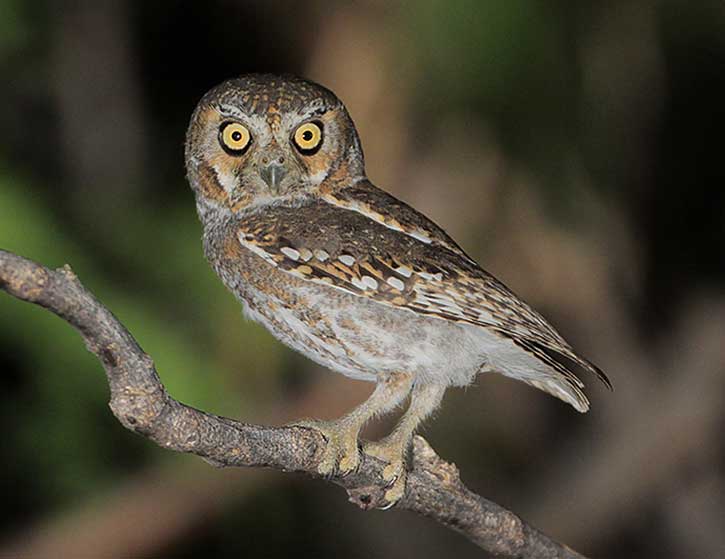The Elf Owl is the world’s smallest raptor! These owls are compact, tiny owls that don’t have any ear tufts. Additionally, they are easy to recognize by their large heads for their size, short tails, and solid, small feet.
They live in various habitats on the southern border of the United States and Mexico. Elf Owls take advantage of old woodpecker nest holes and cavities similar to those. These owls will come out of their cavities at night to hunt small prey.
Identification
Male and female Elf Owls look identical. Because of this, it can be hard to tell them apart. These birds have blotches of brown, rufous, gray, and white with a facial disc framed in black.
Elf Owls are smaller than Hairy Woodpeckers but larger than Bewick’s Wrens.
In southern parts of Texas, some of these birds have less rufous in their plumage. They also have yellow eyes, short tails, light eyebrow markings, and no ear tufts.
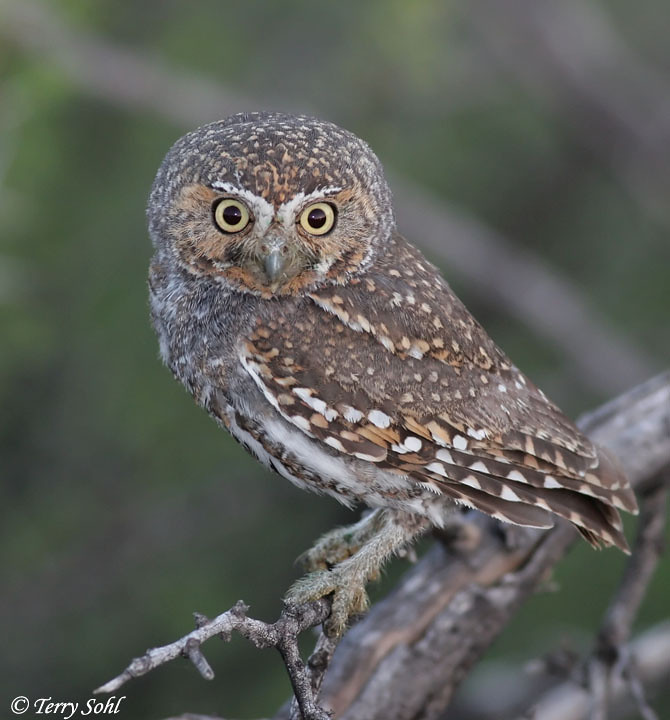
©Terry Sohl
Juvenile Elf Owls are grayer overall in comparison to adult birds and have a small amount of brown coloration.
Adults are 4.7 to 5.5 inches (12 to 14 centimeters) in length, weigh 1.2 to 1.9 ounces (35 to 55 grams), and have a wingspan of 13.0 inches (33 centimeters).
Food
The Elf Owl has a unique diet. Most small owls eat small birds and small mammals. However, Elf Owls don’t consume small birds and mammals.
Instead, their diet mainly consists of arthropods and insects. The prey they consume most often are moths, crickets, and beetles. However, they’ll also consume grasshoppers, cicadas, katydids, mantids, flies, stick insects, lacewings, wasps, spiders, bees, centipedes, vinegaroons, scorpions, lizards, rodents, and snakes.
Elf Owls are incredibly agile, acrobatic birds, especially when they’re foraging and capturing insects in flight or off the ground. They have razor-sharp vision and incredible hearing. They utilize low perches, are extremely sensitive to the slightest movement or sound, and will quickly fly to capture their prey with either their talons or bill.
Some unique things these birds do is hang upside down from foliage to remove prey and chase insects on foot. With some prey, such as wasps, scorpions, or sphinx moths, they’ll manipulate them carefully in their bill and with their feet to remove unwanted parts such as stingers and wings.
Nesting and Eggs
At the beginning of the breeding season, male Elf Owls will sing continuously and loudly at night to attract a female and defend their territory.
When courting, the male will feed the female and will sing from inside the potential nesting hole to lure the female to it.
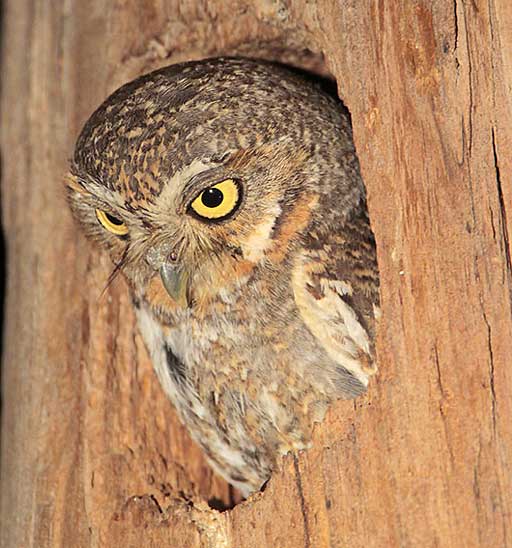
Elf Owls will utilize quite a few different things for a nest cavity. However, they prefer to use old woodpecker holes in giant cacti and trees or nesting boxes.
The height of the nesting site can vary, but they’re usually 15 to 50 feet above ground in streamside sycamores and 10 to 30 feet up in saguaros.
- Clutch size can be anywhere from 1 to 5 eggs.
- Elf Owls have 1 brood every breeding season.
- Egg length ranges from 1.1 to 1.2 inches (2.7 to 3 centimeters).
- Egg width ranges from 0.9 to 1.0 inches (2.3 to 2.5 centimeters).
- The incubation period is around 24 days.
- The nestling period is anywhere from 28 to 33 days.
- Elf Owl eggs are white.
- Hatchlings are unable to sit up and are covered in thick white down.
Current Situation
The Elf Owl lives in several different habitats located in Southern Texas and Mexico. In southern Texas, they’ll inhabit Texas persimmon, brushy thorn forest, Mexican leadtree, black willow, southern hackberry, mesquites, acacias, and Texas cedar elm. Along the Rio Grande river, these birds will use eastern cottonwood, riparian forest with Texas ebony, anacua, and black willow.
Additionally, they will inhabit deserts as well. In western Texas, they can be found in forests and washes with screwbean mesquite and honey mesquite, as well as higher-elevation riparian corridors with ashes, willows, maples, walnuts, and cottonwoods. They can be seen in habitats as high as 5,400 feet in elevation.
In the Chihuahuan Desert, Elf Owls will nest in cavities in agave and yucca flower stocks or riparian areas with cottonwood, Emory oak, black willow, chinkapin oak, and gray oak. In the Sonoran Desert, they’ll use desert ocotillo, ironwood, tall columnar cacti such as saguaro, and palo verde.
In the taller canyons, these tiny owls prefer Fremont cottonwood, willows, riparian stands with Arizona sycamore, ashes, junipers, oaks, netleaf hackberry, Arizona alder, Chihuahuan pine, and Arizona walnut.
Elf Owls will tolerate some development in their habitats and are more than willing to accept nesting boxes. In southern Mexico, where they winter, their habitats closely resemble the ones they use in their nesting grounds.
Facts
- Elf Owls are no bigger than a juice box! Their size makes them the smallest raptor in the world!
- Snakes are a significant part of raptors’ diets, however, not for Elf Owls. Instead of eating snakes, Elf Owls will catch blind snakes (also called thread snakes) and take them back to the nest. The snakes are alive when they’re brought back to the nest and are left there to consume parasites that might harm the nestlings.
- Elf Owl pairs sometimes come together to mob predators like larger owls, mammals, and snakes during the nesting season. “Mobbing” is said to scare off predators by getting rid of their ability to surprise prey. It’s also theorized that it may help younger birds recognize predators.
- Elf Owl nests in the southern U.S. will usually have tree ants. These ants do not hurt the owls or their nestlings. Instead, they eat what’s left behind of their meals and eat nest parasites.
- The oldest recorded wild Elf Owl lived to be at least 5 years and 10 months old.
Similar Species
The Elf Owl has features that are similar to other bird species. Here are some similar species:
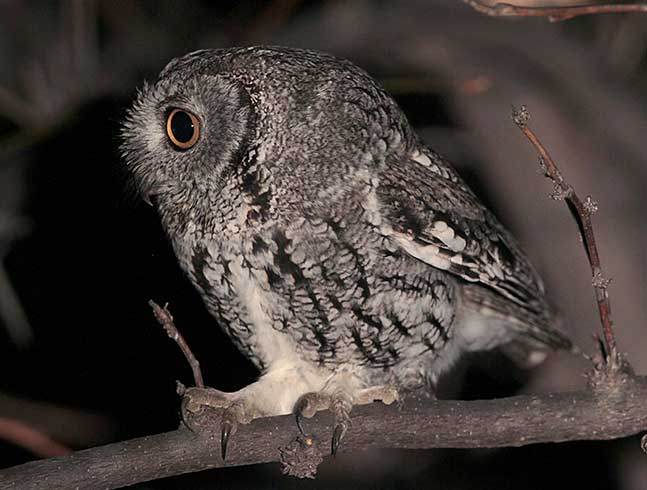
Western Screech-Owl
Elf Owls are smaller than Western Screech-Owls and don’t have ear tufts.
In addition, Elf Owls have light eyebrow markings and blurry markings, while Western Screech-Owls don’t have eyebrow markings and sharper markings in their underparts.
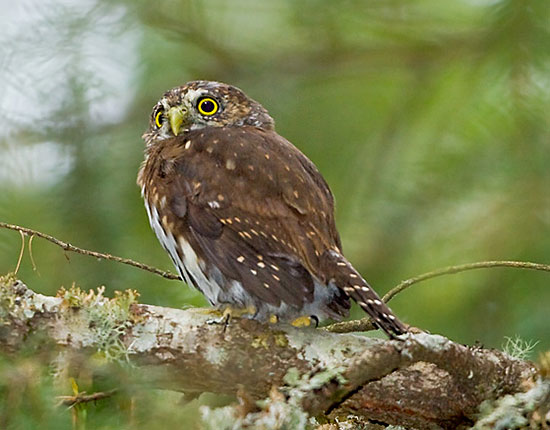
Northern Pygmy Owl
Northern Pygmy-Owl
Elf Owls have shorter tails than Northern Pygmy-Owls. Northern Pygmy-Owl tails extend past the wings when they’re perched.
Additionally, Northern Pygmy-Owls are usually active during the day, while Elf Owls are active at night.
Finally, Elf Owls have blurry streaking, while Northern Pygmy-Owls have neater streaks on their underparts.
FAQ
Are Elf Owls rare?
Elf Owls are rare and can be hard to see due to them being active at night.
What is unique about the Elf Owl?
Elf Owls are unique because they’re the smallest raptor in the world and will bring blind snakes to their nest, so they can consume parasites to keep the nestlings safe.
How many Elf Owls are left in the world?
There are around 200,000 Elf Owls in the world.
Are Elf Owls aggressive?
No, Elf Owls are not aggressive. They prefer to fly away instead of fight.
Is an Elf Owl a predator?
Yes, Elf Owls are predators. They love to eat moths, crickets, and beetles.

